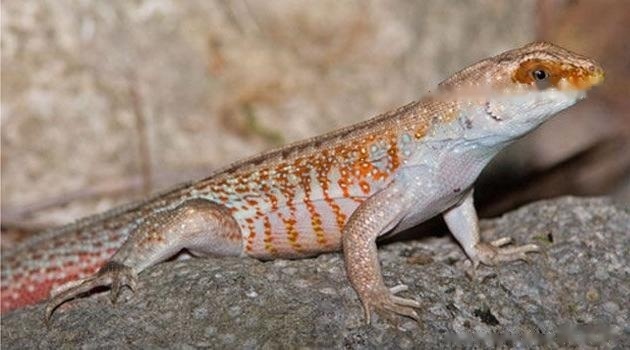The Haitian spring lizard, also known as the Haitian curly-tailed lizard, is a genus of spring lizards distributed in Latin and Central America. The genus includes 28 different species, distributed in Central and Latin America ; There are two species that have appeared on the domestic market, namely the Haitian striped spring lizard and the Bahamian spring lizard. They are very territorial and adult males cannot be kept in groups. The character is extremely active, very fond of fast crawling and jumping, nodding up and down when excited, accompanied by its signature movement: curling its tail like a spring. That's why some people call them Haitian curly-tailed lizards.

1. External morphological characteristics of the Haitian spring lizard
The Haitian spring lizard is 15-27 cm in length. The male lizard has black stripes on its eyes and green limbs . The back is red with many white spots, while the female lizard's body color is mainly brown. The body and tail also have very distinct squamosal scales arranged in bands. Among them, there are 15 scales on the body. Males have about 26-32 crotch holes. Small in size, with external ear holes, and the tympanic membrane is superficial or deep. The tongue is well developed, flat and muscular.
2. Population status of Haitian spring lizards
Haitian spring lizards are distributed in Haiti and surrounding islands, such as the West Indies, while Bahamian spring lizards are distributed in Bahamas, Cayman Islands ( Latin America), Cuba and Florida, USA (introduced to the United States, non-native species). Due to its tenacious environmental adaptability, the spring lizard population has grown rapidly in the southern United States; excessive populations have led to a huge demand for food, which seriously threatens the survival of the small lizard in the native United States.
3. Feeding methods of Haitian spring lizards
【Arrangement】
Spring lizards are lizards in dry areas, and the environment requires low humidity. However, it doesn't have to be too harsh to raise, as long as it is not too careless to make the environment more humid, it is generally not a problem. It is recommended to use reptile sand, and dry coconut bricks are also acceptable. Note that the pad should be thick and easy to drill in, because the spring needs to sleep in the pad at night. The layout of the environment needs to be three-dimensional, and there is climbing as well as avoidance. Spring lizards like to run and jump back and forth in the tank during the day, so the three-dimensional environment is very important.
【Feeding】
The Haitian spring lizard is omnivorous, but mainly eats insects. Home-raised Haitian spring lizards typically feed on small crickets, mealworms, or small barley bugs. Since this species is not a picky eater, it can theoretically be fed as long as it is a non-toxic insect. Sometimes the spring lizard even preys on a male Dubia cockroach that is almost the same size as it when it is hungry, and successfully dismembers it and devours it, showing its strong predation ability. Vegetables and fruits are eaten in small amounts, and some individuals do not eat them. Players can try feeding them during breeding.
【Daily】
The Haitian spring lizard likes to sunbathe, but frequent sunbathing will cause the temperature in the cage to be too high, which is not only detrimental to the physical and mental health of the spring lizard, but also harmful to it. Occasional sunbathing is enough. For Haitian spring lizards, ultraviolet rays are as indispensable in life as food and drinking water. The family-bred patterned spring lizards are illuminated by sun lamps, from morning to night, for about 12 hours a day, which can achieve sufficient effects. The intensity of ultraviolet lamps is much stronger than that of sun lamps. Excessive ultraviolet rays can harm animals, and also have the risk of sunburn and blindness. It is enough to expose for 10-20 minutes a day. Spring lizards can be raised in a fish tank with white sand on the bottom of the tank. When the weather is hot, a water basin can be placed for drinking and bathing to cool down; when the temperature is 10-20 degrees, it should be placed in a Put a piece of cloth in the tank and let it climb on it and cover it with a piece of cloth when sleeping at night to keep it warm. The cloth used should be made of pure cotton.
![[Dog Training 5] The training method of pet dog dining etiquette](/static/img/12192/12192_1.jpg)




